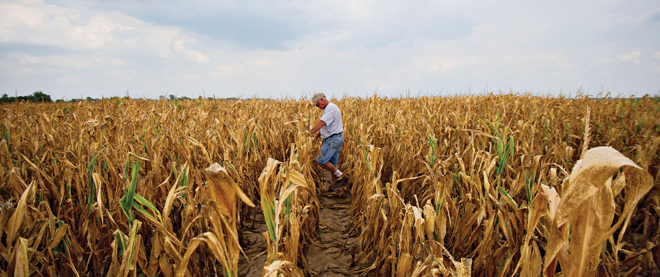North America’s corn belt is baking, and everyone is about to feel the burn
The worst draught in a quarter-century is threatening the global food supply
Daniel Acker/Bloomberg/Getty Images
Share

Fred Below has never grown corn in hell, but this summer he’s gotten a sense of what it might be like. “Your crop would be burning up,” he surmises in Midwest deadpan, “and you’d be telling the Devil, ‘Man, we need rain bad.’ ” A crop biologist with the University of Illinois at Urbana-Champaign, Below is given to neither blasphemy nor idle humour. In recent weeks, he’s watched with dismay as the corn he grows on four research farms throughout the state has curled and shrank in the face of a seemingly infernal heat wave.
As his crops go, so does the great North American corn belt. Grappling with the worst drought in a quarter-century, farmers in the normally verdant lands stretching from Nebraska to southern Ontario are looking ahead to a harvest bust, as the stalks in their fields fade to yellow and nod toward the earth. Under the husks, the kernels have shrivelled to rubbery grains, meaning that the quality of the surviving corn is declining, even as maize prices soared this week toward a record US$8 a bushel.
Last week, the U.S. Department of Agriculture cut its overall forecast of America’s harvest by 12 per cent, noting that three-quarters of the country’s corn-producing land sits in a drought zone where as little as 10 mm of rain has fallen since early June. In Illinois, as much as a third of the crop could be lost, says Below, and even a sudden dose of moisture won’t turn things around. The heat struck during a critical period in plant development, he explains, desiccating pollen just as the transfer process was about to begin. “Right now, we’re setting the potential number of kernels on the plant,” he says. “During that period, hot and dry are as bad a set of conditions as can be.”
The impact will be felt beyond the farm belt, say experts, because few agricultural commodities permeate the food supply as completely as corn. Over the past three decades, the crop has become the wellspring of the Western diet, serving as the ballast in our breakfast cereals, the sweetener of our soft drinks and—increasingly—fodder for the growing number of cattle we turn into steaks. When the price of corn rises, everyone gets pinched.
That doesn’t count the fancy-grade stuff we put on the table—a cash crop Ontario farmers were scrambling to rescue this week as temperatures rocketed to 37° C, and rain remained a tantalizing rumour. In Scotland, Ont., about 125 km southwest of Toronto, workers at the Welsh Bros. Corn Farm were draining their irrigation ponds to keep the sweet corn alive, knowing their efforts would go for naught if the dugouts weren’t replenished. As of Tuesday, the weather station in nearby Simcoe had recorded just 1.3 mm of precipitation since Canada Day. “We’re seeing damage to the crop and I’m expecting yields to go down,” said co-owner Peter Welsh. “I haven’t seen it this bad in my life.”
How widely—and keenly—the pain will be felt is a matter of debate. Michael Swanson, an agricultural economist with Wells Fargo & Co., has described the shortage as “a US$50-billion event” for the U.S. economy, noting that corn prices had climbed some 46 per cent above their mid-June levels. The spike came, he notes, just as consumers were expecting a break from a longer-term rise in food prices connected to overseas demand and the world’s increasing fondness for corn-fed meat. Global economic uncertainty had eased those pressures, says Swanson, but the relief was short-lived. “We are already at record-high prices for proteins and dairies,” he says. “Lower income consumers will really feel the impact of higher corn prices.”
Others, however, aren’t ready to hit the panic button. Sylvain Charlebois, a University of Guelph economist who has studied world food prices, points out that less American corn is going to ethanol production this summer, after Congress ended a 12-cent-per-litre tax credit for fuel makers last winter. The world economy remains in neutral, he adds, which could hold down demand for meat and dairy products. “American consumers are really struggling,” Charlebois says, “and when it comes to meat and proteins, I’m not so sure they’re willing to pay more. If they believe beef is too expensive, they’re probably going to trade down to chicken or pork. There are lots of substitutes out there.”
Still, he hastens to add, the drought points out a new reality faced by consumers and farmers: volatile markets trying to come to grips with capricious climate conditions—a combination that, for Kevin Miles of Waterford, Ont., has begun to feel like Fred Below’s special version of hell. Last year, he lost much of his corn to a record deluge of spring rain. This summer, the clouds keep bypassing the 50-year-old’s 647 hectares of crop land, raising the prospect of another subpar yield. “It’s in a farmer’s nature to like to watch stuff grow,” Miles says ruefully. “Seeing it die instead, right in front of you, is not much fun.”